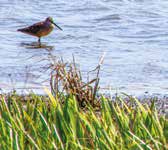
Living on the Edge: Part 2
By Jerry Culp
The Importance of the Edge Between Habitats: A Crucial Ecological Transition
 This article is a continuation from the Spring edition of the Prairie Islander; you can find Part 1 on our website under Information > News & Media.
This article is a continuation from the Spring edition of the Prairie Islander; you can find Part 1 on our website under Information > News & Media.
3. Facilitating Ecological
Interactions The ecological interactions between species are often heightened at habitat edges. These interactions can include pollination, seed dispersal, and the movement of animals between habitats. For example, some birds and insects that live in woodlands may use prairie edges to forage for different types of food, such as seeds or insects that thrive in more open environments. Similarly, mammals like deer or foxes may travel between the forest and open fields to find food and shelter. These movements across the edge contribute to genetic exchange and increase the resilience of populations.
Moreover, plants that live at the edge often benefit from crosspollination between species that are found in both habitats. The presence of pollinators like bees and butterflies may be more frequent at these transitions, as they are attracted to the variety of plant species present at the edge.
4. Buffer Zones and Resilience to Change
Edges often act as buffers against environmental stressors, helping to protect interior ecosystems from extreme events like fires, storms, or droughts. For example, the edge of a forest may be less prone to fire because the moisture from the woodland creates a natural barrier that prevents flames from reaching the interior. Similarly, the vegetative cover at the edge of a wetland can act as a natural filter, reducing the impact of floods and protecting the integrity of the ecosystem.
In the face of climate change, species may shift their ranges in response to changing temperatures and weather patterns. Ecotones are often areas where species can migrate to find new habitats that offer suitable conditions. For instance, as temperatures rise, certain plant or animal species may move into higher elevations or latitudes, and these edges offer a crucial pathway for their movement. In this
way, edges help ecosystems adapt to changing environmental conditions, ensuring resilience in the face of global change.
This article is a three-part series which will be concluded in the winter edition of the Prairie Islander.

